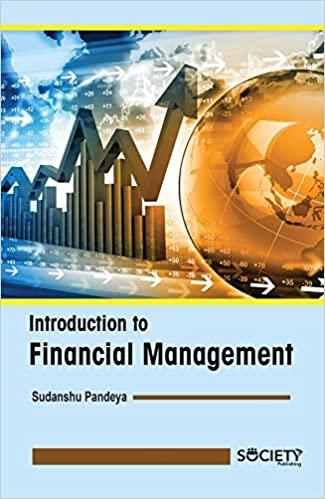Question
During the last few years, David Harris Industries has been too constrained by the high cost of capital to make many capital investments. Recently, though,
During the last few years, David Harris Industries has been too constrained by the high cost of capital to make many capital investments. Recently, though, capital costs have been declining, and the company has decided to look seriously at a major expansion program that has been proposed by the marketing department. Assume that you are an assistant to Leigh Jones, the financial vice-president. Your first task is to estimate David Harriss cost of capital. Jones has provided you with the following data, which she believes may be relevant to your task:
1. The firm's tax rate is 35%.
2. The current price of David Harriss 8% coupon, semiannual payment, noncallable bonds with 15 years remaining to maturity is $1,085.27. David Harris does not use short-term interest-bearing debt on a permanent basis. New bonds would be privately placed with no flotation cost.
3. David Harriss common stock is currently selling at $60 per share. Its last dividend (D0) was $2.50, and dividends are expected to grow at a constant rate of 5.2% in the foreseeable future. David Harriss beta is 1.25; the yield on T-bonds is 3.5%; and the market risk premium is estimated to be 7%. For the over-own-bond-yield-plus-judgmental-risk-premium approach, the firm uses a 2.4% judgmental risk premium.
4. David Harriss target capital structure is 40% long-term debt and 60% common equity.
To help you structure the task, Leigh Jones has asked you to answer the following questions.
1. What sources of capital should be included when you estimate David Harriss weighted average cost of capital (WACC)?
2. Should the component costs be figured on a before-tax or an after-tax basis?
3. What is the market interest rate on David Harriss debt, and what is the component cost of this debt for WACC purposes?
4. What are the two primary ways companies raise common equity?
5. Why is there a cost associated with reinvested earnings?
6. David Harris doesnt plan to issue new shares of common stock. Using the CAPM approach, what is David Harriss estimated cost of equity?
7. What is the estimated cost of equity using the discounted cash flow (DCF) approach?
8. Suppose the firm has historically earned 15% on equity (ROE) and retained 8
0% of earnings, and investors expect this situation to continue in the future. How could you use this information to estimate the future dividend growth rate, and what growth rate would you get? Is this consistent with the 5.2% growth rate given earlier?
9. Could the DCF method be applied if the growth rate was not constant? How?
10. What is the cost of equity based on the bond-yield-plus-judgmental-risk-premium method?
11. What is your final estimate for the cost of equity, rs?
12. What is David Harriss weighted average cost of capital (WACC)?
13. Should the company use the overall, or composite, WACC as the hurdle rate for each of its divisions?
14. What procedures can be used to estimate the risk-adjusted cost of capital for a particular division? What approaches are used to measure a divisions beta?
Step by Step Solution
There are 3 Steps involved in it
Step: 1

Get Instant Access to Expert-Tailored Solutions
See step-by-step solutions with expert insights and AI powered tools for academic success
Step: 2

Step: 3

Ace Your Homework with AI
Get the answers you need in no time with our AI-driven, step-by-step assistance
Get Started


